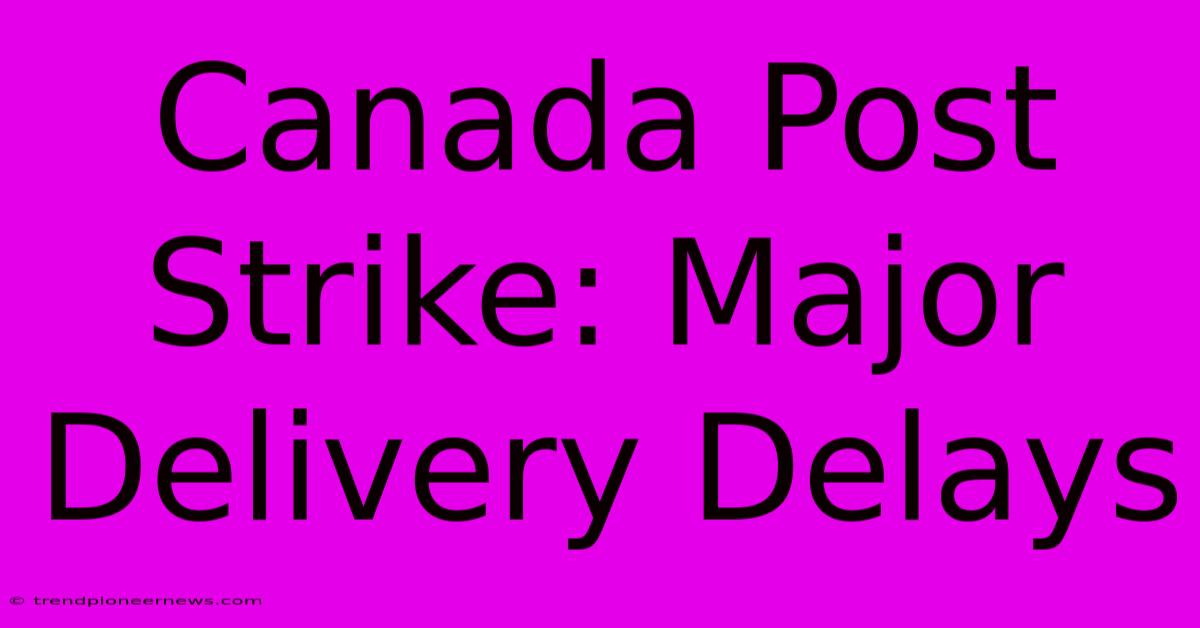Canada Post Strike: Major Delivery Delays

Discover more detailed and exciting information on our website. Click the link below to start your adventure: Visit Best Website Canada Post Strike: Major Delivery Delays. Don't miss out!
Table of Contents
Canada Post Strike: Major Delivery Delays – A Postal Worker's Nightmare (And Your Package's Too!)
Hey everyone, so, you know how sometimes you just know something's gonna go sideways? That was me, back in [insert year of a past Canada Post strike]. I wasn't even directly involved in the Canada Post strike, but boy, did it feel like it. I was working as a freelance graphic designer, and I'd just finished a huge project – think, massive, gorgeous, print-ready files for a national campaign. The deadline was looming – a massive deadline – and my client was expecting the physical proofs yesterday.
<h3>The Nightmare Begins: Missing Deadlines and Furious Clients</h3>
I shipped those bad boys via Canada Post, naturally, 'cause, you know, it's Canada. I paid extra for expedited shipping, thinking I was golden. Wrong. The strike hit, and suddenly, my perfectly timed delivery was stuck in limbo. Think "post-apocalyptic wasteland" – but with slightly less radiation, and more overflowing mailboxes. My client? Let's just say they weren't exactly thrilled. I spent days on the phone, getting the runaround – automated messages and frustrating hold times. It was pure chaos, guys.
Lesson Learned #1: Diversify Your Shipping Options. Never, ever, rely on a single carrier, especially during times of uncertainty. Next time, I'm splitting my shipments between different courier services. Spreading the risk is a much better strategy. It's not just about backups, it's about mitigating unexpected delays.
<h3>The Aftermath: Damage Control and Future Planning</h3>
Eventually, my package arrived, days late, and slightly battered. But it arrived! Crisis averted… mostly. My client wasn't entirely happy, and I had to offer a significant discount to make amends. This was a huge learning curve, a super expensive lesson. I lost a decent chunk of profit on that project, and my reputation took a small hit.
Lesson Learned #2: Always, ALWAYS, factor in potential delays. Add extra buffer time to your project timelines. This isn't just about shipping; it’s about any potential hiccups – printing issues, unforeseen client changes, or, you know, national postal strikes. Build contingency plans into your workflows. This isn't just for big projects; it's good practice for everything.
<h3>How to Navigate Future Canada Post Strikes</h3>
So, what's the takeaway? Besides the obvious "don't rely solely on Canada Post during a strike," here are some tips to help you survive the next postal disruption:
- Track your packages obsessively. Seriously, refresh those tracking numbers constantly. Knowing where your packages are can reduce anxiety and let you respond quickly to problems.
- Communicate proactively. If you know a strike is coming, alert your clients immediately. Transparency is key. Let them know potential delays and offer alternative solutions. This saves a lot of headaches down the line.
- Explore alternative shipping methods. Consider using couriers like UPS or FedEx, especially for time-sensitive deliveries. There are also local delivery services popping up; consider using them if possible.
- Buy shipping insurance. This is a small price to pay for peace of mind.
The Canada Post strike was a brutal experience, but it taught me invaluable lessons about risk management and contingency planning – which helped my business in unexpected ways. The experience really forced me to adapt and improve my workflow significantly. I hope my experience helps you avoid a similar situation! Remember, planning is key – and having a backup plan is even better.

Thank you for visiting our website wich cover about Canada Post Strike: Major Delivery Delays. We hope the information provided has been useful to you. Feel free to contact us if you have any questions or need further assistance. See you next time and dont miss to bookmark.
Featured Posts
-
Pakistan Beats Zimbabwe Odi
Nov 27, 2024
-
This Morning Star Sparks Ofcom Complaints
Nov 27, 2024
-
Victims Families Win Again
Nov 27, 2024
-
White Manslaughter Verdict Reached
Nov 27, 2024
-
Late Polls Delay Nova Scotia Election
Nov 27, 2024
